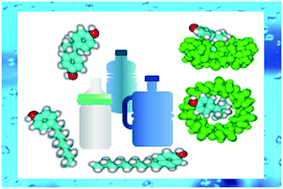Spectrofluorimetric study of phenolic endocrine disruptors in cyclodextrin media
Abstract
This study focuses on the spectrofluorimetric behavior of bisphenol A (BPA), 4-octylphenol (OP) and 4-nonylphenol (NP) in the presence of native and derivative cyclodextrins (CDs). The weak fluorescence emission bands of these endocrine disrupting compounds in aqueous media are significantly enhanced by β-CD and its hydroxyethyl-, hydropropyl, methyl-, and heptakis(2,6-di-o-methyl)-derivatives. A 1 : 1 guest : host stoichiometry for most complexes is established, although the additional presence of weak 1 : 2 complexes is suggested in both BPA–hydroxyethyl–β-CD and BPA–heptakis(2,6-di-o-methyl)–β-CD systems. The association constants are calculated by applying a non-linear regression method to the changes brought about by the presence of each CD in the corresponding fluorescence spectra, and these values are corroborated using a Benesi–Hildebrand type equation. The participation of the CD substituents in the inclusion phenomenon is indirectly demonstrated through the comparison of the acidity constant values in the absence and in the presence of β-CD derivatives. On the basis of 1H-NMR studies, possible structures of the formed complexes are suggested, and the structural information is supplemented by AM1 semiempirical calculations. The potential of the studied complexes in relation to their use for analytical purposes and/or for environmental remediation is discussed.


 Please wait while we load your content...
Please wait while we load your content...